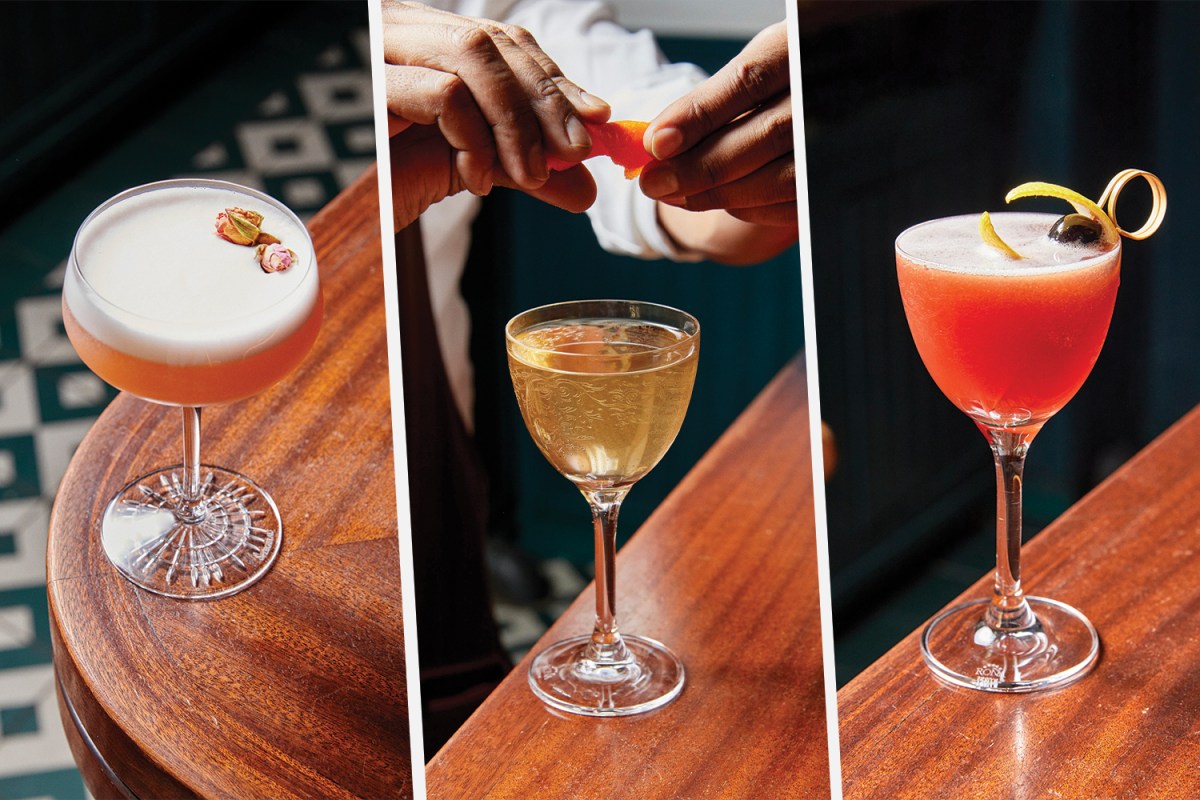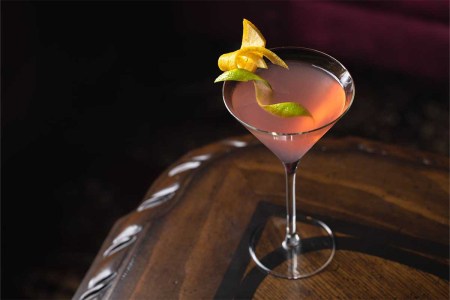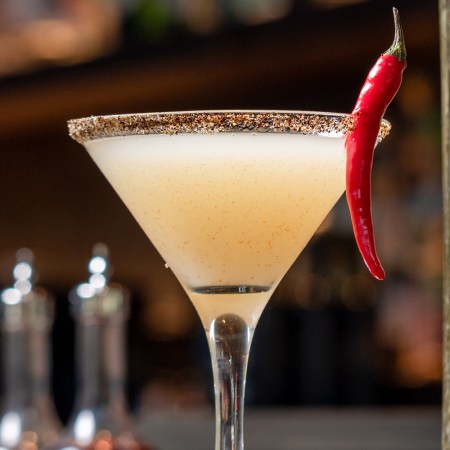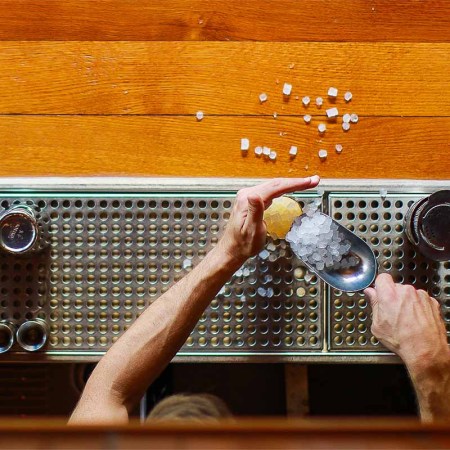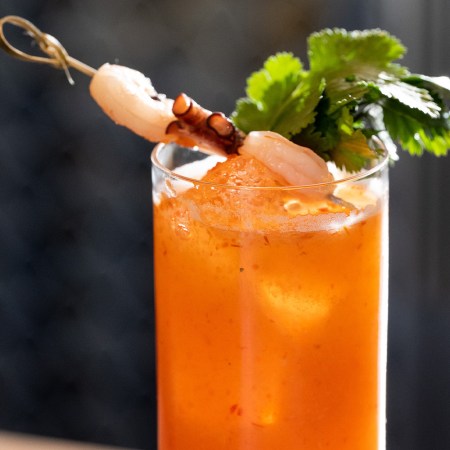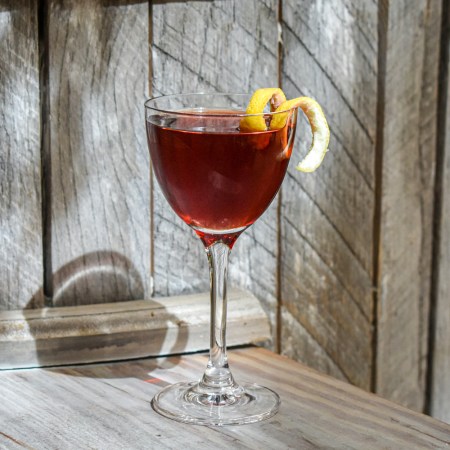“I shook it myself!” exclaimed the server with glee. One of his arms was ceremoniously folded across his back as he set a Manhattan before me at an upscale Midtown New York City restaurant. There was some impressive froth on that drink, and I didn’t have the heart to send it back for a stirred do-over. I soon found out it was restaurant bar policy that every cocktail, regardless of recipe (with or without juice), was shaken there — not because of a signature style preference, but because they thought they had to.
This Manhattan incident occurred at least 20 years ago, before cocktail culture had caught up to most fine dining beverage programs in mainstream America. During a recent visit to Union Square Cafe, I was presented with a Last Straw. The summer cocktail deftly balances the sweet-tart-aromatic elements of gin, rum, strawberry, rhubarb and basil, served as a clarified punch with a piped savory basil ice cream garnish, ingredients that come straight from the same nearby Greenmarket that also inspires the seasonal kitchen menu (the joke is that the cocktail takes two days to make and as many minutes to drink). Another cocktail on the list is a subtly smoky Margarita twist made with watermelon, mezcal and hot honey that’s neither too sweet nor aggressively spicy. These drinks are a far cry from the “name your tini” culture I remember from the early days of the original namesake location (established by Danny Meyer in 1985, USC relocated to Park Avenue South in 2015). As an in-joke, there’s now a Dirty Appletini on the menu, served with pickled apple.
Cocktail-focused venues like Manhatta and Porchlight are now part of the Union Square Hospitality stable, which also includes Gramercy Tavern and the Modern, both of which have amped up their cocktail programs in recent years. “It’s a welcome challenge to honor a place that’s been around so long,” says USC beverage director Michael Beck. He says the goal is to serve cocktails that are as memorable for the overall dining experience — whether that’s solo at the bar or at a table in the dining room — as the food and wine. No Manhattans with a foamy skyline here, unless, of course, the customer specifically requests one. (They are known for their bend-over backwards approach to hospitality, after all.)
Meanwhile, over in the Garden State, Francis Schott and business partner Mark Pascal have been mixing cocktails and fine dining since the early 1990s at Stage Left Steak — and later at its sister venue, Catherine Lombardi — in New Brunswick. They had both worked as bartenders in the 1980s and were initially serving drinks like Fuzzy Navels and Lemon Drops as they alternated shifts behind the Stage Left bar. Then they became friendly with the then Rainbow Room bar manager Dale Degroff at a tristate monthly steak meetup called the Red Meat Club.
“I was a wine guy,” Schott says. “But Dale taught me that cocktails can be every bit as complex as wine.” He says he was invited to visit the Rainbow Room to see how the ‘cocktail game’ was played. “I took the elevator thinking I knew everything about cocktails,” he adds. “When I took it down, I realized I had known nothing.” By 1992, with Degroff’s consultation, Stage Left had what was considered the first craft cocktail program in New Jersey and held one of the state’s first cocktail pairing dinners.
Schott says that because they were relatively early on the modern craft cocktail scene, it took time for Jersey bar customers to understand certain fresh ingredients in their drinks. “You can’t put egg whites in my drink — that’s disgusting!,” some said.
By the early 2000s, cocktails and fine dining had started to take off in the New York metro area, partially because of tragedy. Gina Chersevani has been a bar consultant since the 1990s, and her first cocktail menu was conceived for (the now closed) Penang restaurants in NYC for one of the first Restaurant Weeks, which was a way to draw diners back to restaurants in the wake of 9/11 with discounted two or three-course pre fixe menus. Her Restaurant Week Cucumber Martini made the first edition of Difford’s Guide to Cocktails at a time when there were very few modern cocktail recipe compilations in print. Most bartenders, even Degroff in the early days of his Rainbow Room tenure, consulted Jerry Thomas’s Bartenders Guide, if they used any resource at all.
Why NYC’s New Cocktail Bars Are Embracing the City’s Past
Nostalgia and appletinis drive the menus at these just-opened watering holesChersevani moved to Washington, D.C. to set up the menu for an outpost of Penang, and by 2005, oversaw the bar program at Rasika Penn Quarter, one of the country’s first major upscale eastern Indian restaurants. “D.C. was right behind the NYC [fine dining] movement, and you wanted the win — Beard, Star Chefs, etc,” she says. “After the first couple of Tales of the Cocktail, fine dining couldn’t not have cocktail lists.” She points out that the relationship between restaurant bar programs and back of house is integral, that the two should complement each other. One of her early mentors was chef Jamie Leeds, who was then at USC and now helms her own restaurant group.
In San Francisco’s Embarcadero waterfront neighborhood, William Prestwood is the beverage director for Boulevard, which has been open since 1993. He says he owes a large part of his cocktail program’s inspiration to chefs Nancy Oakes and Dana Younkin. “I love working with culinary professionals on such a high-level,” he says. “I’m inspired by the way our kitchen is run, with respect for those who make up the heart of the operation and the precision and passion it takes to put out food at the level they do. I have learned so much about culinary techniques, food and leadership from the team here.”
Prestwood has 26 years of hospitality experience and has worked at restaurant bars since 2007. He says that like USC, Boulevard was initially an everything-tini spot, but by the early 2000s, there was a shift. “Since local, seasonal, fresh, sustainable ingredients and attention to detail have become standard throughout our city, we have acutely sharpened our focus in that direction.”
One of the features that sets that program apart is listing the cocktails by spirit type and potency, with “Bright and Shaken” and “Spiritous” sections, which Prestwood has put in practice since he bartended at local tiki cocktail haven the Tonga Room in the Fairmont San Francisco in 2013. These days, as with the other restaurants featured here, there is a section on the Boulevard menu for non-alcoholic drinks. “Welcoming everyone is a big part of hospitality, and a well thought out non-alcoholic section says, ‘We were anticipating your arrival and have experimented to discover what the best or most interesting things we have to offer you are,’” Prestwood says.
Though there is an expectation for seasonality at contemporary restaurant cocktail programs, certain drinks are mainstays by popular demand. Beck says customers have come to expect the Umeshi Highball and calls the house Espresso Martini an “impenetrable force” — espresso used to be prepared à la minute, but the drink is so popular that head bartender Patrick Smith keeps four to six pulls on ice behind the bar at a time for his recipe. Servers have come to know that an empty tin on the bar indicates more is needed, stat!
Schott says the Parasol — an Aperol Pisco Sour variation that was later adopted by the late Milk & Honey founder Sasha Petraske for the John Dory in NYC — is a staple at both of his restaurants. They also always serve an upscale Brandy & Port. “That’s how you know you’re in a real Irish bar,” he says. Naturally, at Boulevard, the never-changing customer favorite is a Boulevardier.
How far have eatery cocktails come in the past couple of decades? One of the restaurants run by Chersevani is Buffalo & Bergen, which has two locations — Capitol Hill and Union Market. Sure, it’s mainly a knish and bagel spot, but with a significant fresh ingredient cocktail program to match. “These days, you really can’t miss a step,” Chesevani says.
Every Thursday, our resident experts see to it that you’re up to date on the latest from the world of drinks. Trend reports, bottle reviews, cocktail recipes and more. Sign up for THE SPILL now.
